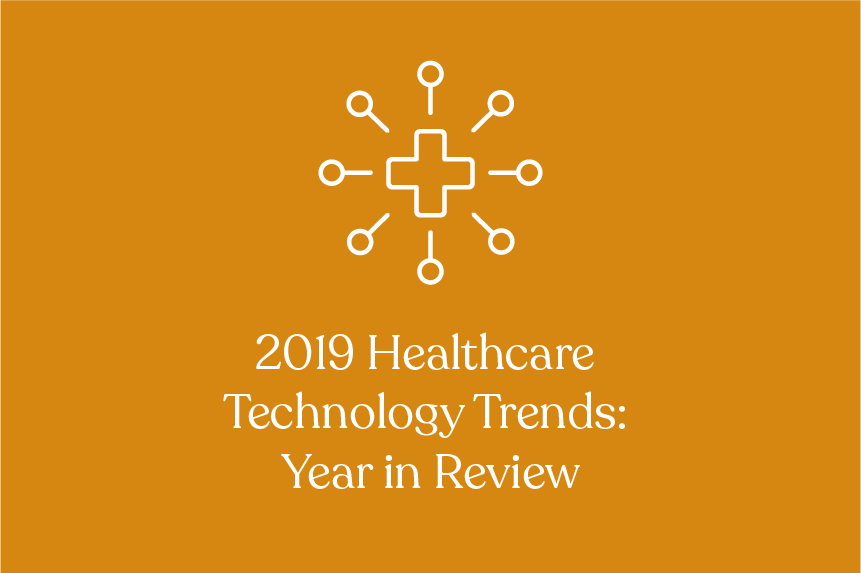Of all the industries in which technology plays an important role, healthcare is one of the most crucial. In healthcare, technology can help solve staffing issues, improve efficiencies, enhance the relationship between medical professionals and patients and, ultimately, provide cheaper, faster and more effective healthcare solutions like pharmaceutical drugs and patient treatment plans.
Earlier this year, Definitive Healthcare released an infographic predicting 2019’s top healthcare information technology (HIT) adoption trends. From AI to telehealth, let’s recap our 2019 predictions, and look ahead to some 2020 trends.
1. Artificial Intelligence (AI)
With 2.5 quintillion bytes of data generated each day, healthcare organizations have access to more data than they know what to do with – and are starting to look toward “artificial intelligence” or “augmented intelligence” (AI) and machine learning technologies as a means to solve many future problems.
With an increasing number of physicians and healthcare providers reaching retirement age, AI is going to become a major solution in the ongoing healthcare staffing shortage: creating efficiencies in the treatment process and reducing the total number of doctors required throughout a given care episode.
In radiology, physicians will be better able to triage by creating efficiencies in the x-ray screening process, thereby allowing radiologists to focus their attention on the most crucial exams first. And, AI may help doctors diagnose faster than ever – from mobile applications that screen for cancer and eye diseases, to detection of genetic disorders in infants. Given these scientific breakthroughs, we anticipate that AI will only continue to grow in the years to come.
Read more about 2019’s biggest AI breakthroughs here: 3 Surprising Ways Healthcare is Using AI.
2. Interoperability & HIEs
Given the crowded nature of the healthcare technology vendor market, there is an evergreen need for interoperability solutions. In a fast-paced hospital environment, life is just simpler when systems work together in harmony. Unfortunately, not all technologies are compatible with each other, so the development of ancillary technologies that can bridge these gaps is essential. Moreover, Meaningful Use requirements, new payment approaches that stress care coordination, and federal financial incentives are all driving the interest and demand for health information exchange (HIE).
HIE allows providers and patients to appropriately access and securely share a patient’s medical record online. Currently, over half of U.S. hospitals currently report an HIE implementation, an increase of 864 records from 2018 to 2019. A total of 84 vendors – from EMR solution providers like Epic, Cerner and Meditech, to more niche players such as Aetna and InterSystems – have at least one reported HIE installation at U.S. hospitals.
HIE Installations, 2015-2019
| Year | # HIE Installations |
| 2019 | 4,334 |
| 2018 | 3,470 |
| 2017 | 3,435 |
| 2016 | 3,196 |
| 2015 | 2,625 |
Fig 1: Definitive Healthcare’s Technology Insights Search platform, as of 12/03/2019
As we move forward, population health management, health information exchange (HIE), and business intelligence tools will become critical to effectively managing value-based care delivery.
3. Telehealth
2019 was a big year for telehealth technologies:
- GoodRx acquired telemedicine platform HeyDoctor to provide patients with a direct-to-consumer telehealth service to help patients refill their birth control, review HIV testing, among other common medical issues.
- Amazon launched a Seattle-based pilot program called Amazon Care, which provides employees with access to a virtual medical clinic.
- As of November 2019, a bipartisan Senate bill is now aiming to make it easier for Medicare patients to receive telehealth services from physicians.
This year, Definitive Healthcare also released its 5th Annual Inpatient and Outpatient Telehealth Studies, surveying healthcare providers in the C-Suite and IT Directors/VP categories to track telehealth adoption trends, technology, and services.
Definitive Healthcare’s Inpatient Telehealth Study - Adoption of telehealth solutions or services has surged in the past five years (from roughly 54% in 2014 to 85% in 2019), indicating a higher level of acceptance and desire for telehealth solutions and services. Plans for future telehealth investment have increased significantly from 26% in 2016 to 40% in 2019. Of these future investments 90% are slated to occur in 2020.
Definitive Healthcare’s Outpatient Telehealth Study - Adoption rates of telehealth solutions and services by outpatient physician practices remained relatively flat from 2018 to 2019, hovering at about 44%. The mix of telehealth technology solutions shifted this year, with an increase in two-way video/webcam platforms, mobile applications for concierge services, and clinical-grade remote patient monitoring devices.
Given this outlook, we anticipate that telehealth will continue to play a big role in upcoming years, particularly in the aging baby boomer population via home health agencies and at rural hospitals and clinics.
4. Cybersecurity
An increase in mergers and acquisitions have created new vulnerabilities in information sharing. In 2018 alone, we saw many data breaches that exploited healthcare records; eight of those breaches exposed over 500,000 healthcare records, and three of those breaches revealed over a million. And in 2019, unfortunately, our predictions about the rising number of cybersecurity breaches ended up being correct. This year saw nearly 10 million more cybersecurity breaches and compromised patient records than that of 2018.
According to Definitive Healthcare data, security infrastructure technologies are currently installed at 67.5% of U.S. hospitals, which includes anti-virus and anti-malware software, data back-up systems, encryption, firewalls, spyware filters, and more. While this is high, the percent of health systems with these security technologies is much lower: 6.79% of 884 tracked systems. We expect these numbers to grow over the next few years; healthcare is already high stakes with personal, sensitive data – and will continue to be a main target for attacks.
5. Business Intelligence Systems
Currently, close to half (48.4%) of U.S. hospitals report an installation of clinical Business Intelligence (BI) systems. These technologies help providers with precise decision-making that is clinically focused to help improve quality and safety, reduce costs through more efficient processes, and purchases of medications and supplies. Clinical BI tools focus on creating relevant, actionable information; creating reports and dashboards; monitoring key performance indicators (KPIs) such as Core Measures for external reporting; collaborating with peers and colleagues to make well-informed decisions; performance management; and service line analysis and reporting.
Between 2018 and 2019, an additional 1,200 implementation records were recorded, or a whopping 45% increase, year over year:
Clinical Business Intelligence Installations, 2015 to 2019
| Year | # Installations |
| 2019 | 3,853 |
| 2018 | 2,654 |
| 2017 | 2,452 |
| 2016 | 2,367 |
| 2015 | 2,077 |
Fig 2: Definitive Healthcare’s Technology Insights Search platform, as of 12/03/2019
Technology Trends to Watch in 2020
1. Internet of Medical Things (IoMT)
Frost & Sullivan estimates that around 20 to 30 billion IoMT devices have been expected to deploy by 2020. But what is IoMT, anyway?
IoMT collects data from Wi-Fi-enabled wearable devices like FitBits, digital/virtual assistants like Amazon’s Alexa, automated healthcare kiosks, and even heart activity monitors — and then links these devices to cloud platforms like Amazon Web Services (AWS) to capture and store this data. Essentially, IoMT is an interconnected ecosystem of devices that captures data on an individual and uses that data to better inform decisions and take actions.
Even IoMT-enabled smart homes will help with home health care, including telemedicine (to remotely monitor patients in their homes), remote patient monitoring (to track people with chronic conditions), simple medication reminders, and even motion sensors.
Naturally, given the sensitive and secure nature of this data, there may be further discussion of legislation surrounding IoMT devices in the years to come.
2. 5G Networks
5G networks are poised to be key players in the healthcare market in the coming years. Remote monitoring and telemedicine solutions may have sophisticated imaging equipment, but without the proper network speeds and capabilities, these systems are not nearly as effective. And, as Internet of Medical Things (IoMT) technologies continue to grow, the amount of data on networks may create slower speeds (and frustration, on the part of providers).
5G is the fifth generation mobile network, which can deliver faster speeds and more capacity than that of a 4G network. As this becomes more widespread, we anticipate many healthcare organizations will adapt this new network.
3. Healthcare Blockchain
You may have heard about “blockchain” in the news, particularly surrounding BitCoin and other cryptocurrencies. It’s a form of technology that is able to store information about transactions, record information about who is participating in transactions, and neatly add new data to the string of blocks. In the context of healthcare, there are a few ways where this technology will come into play in the coming years.
- Pharma clinical trials — Blockchain can record clinical trials real time which assists in more comprehensive and accurate data for population health research. This enables patient matching, monitoring and validating data without any data fraud.
- Avoid fraud — Blockchain can keep track of the entire manufacturing chain of each drug. Every new transaction is added to a block which is tracked, timestamped and is immutable — therefore, it cannot be tampered with. On the billing side of things, blockchain addresses billing inaccuracies and frauds with its decentralized records, helping payment processing and preventing forged transactions.
Learn more
Definitive Healthcare tracks all provider organizations’ technology installations and plans for future implementations — including clinical systems, human resources tools, information sharing systems, clinical & business intelligence, cybersecurity systems, and much more. Curious to learn more? Start your free trial today.





